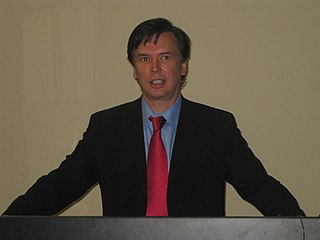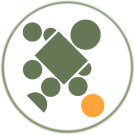
An industrial robot is a robot system used for manufacturing. Industrial robots are automated, programmable and capable of movement on three or more axes.

FANUC is a Japanese group of companies that provide automation products and services such as robotics and computer numerical control wireless systems. These companies are principally FANUC Corporation of Japan, Fanuc America Corporation of Rochester Hills, Michigan, USA, and FANUC Europe Corporation S.A. of Luxembourg.
COLLADA is an interchange file format for interactive 3D applications. It is managed by the nonprofit technology consortium, the Khronos Group, and has been adopted by ISO as a publicly available specification, ISO/PAS 17506.
KUKA is a German manufacturer of industrial robots and factory automation systems. In 2016, the company was acquired by Chinese appliance manufacturer Midea Group.
Robot calibration is a process used to improve the accuracy of robots, particularly industrial robots which are highly repeatable but not accurate. Robot calibration is the process of identifying certain parameters in the kinematic structure of an industrial robot, such as the relative position of robot links. Depending on the type of errors modeled, the calibration can be classified in three different ways. Level-1 calibration only models differences between actual and reported joint displacement values,. Level-2 calibration, also known as kinematic calibration, concerns the entire geometric robot calibration which includes angle offsets and joint lengths. Level-3 calibration, also called a non-kinematic calibration, models errors other than geometric defaults such as stiffness, joint compliance, and friction. Often Level-1 and Level-2 calibration are sufficient for most practical needs.
Robot software is the set of coded commands or instructions that tell a mechanical device and electronic system, known together as a robot, what tasks to perform. Robot software is used to perform autonomous tasks. Many software systems and frameworks have been proposed to make programming robots easier.
Robotics is the branch of technology that deals with the design, construction, operation, structural disposition, manufacture and application of robots. Robotics is related to the sciences of electronics, engineering, mechanics, and software. The word "robot" was introduced to the public by Czech writer Karel Čapek in his play R.U.R., published in 1920. The term "robotics" was coined by Isaac Asimov in his 1941 science fiction short-story "Liar!"

Colin Simpson is a Canadian entrepreneur, software developer, and the author of seven textbooks, including the bestseller Principles of Electronics. With over 500,000 of his textbooks in print, Dr. Simpson is considered as an expert in the teaching of electronics and electronics simulation technology. He has won numerous awards including the Award of Excellence from the Association of Canadian Community Colleges (ACCC), the TVOntario Lifelong Learning Challenge Award, and the Codie award from the Software Publishers Association. Simpson holds two patents in electronics laboratory simulation and control systems technology, and is recognized as an authority on distance education and the integration of laboratory simulation software. He has been interviewed by the CBC, PBS, CTV, TVOntario, The Globe and Mail, Toronto Star, Chicago Tribune, and has lectured at universities around the world. Simpson has a Ph.D. in Electrical Engineering from the University of Hawaii and a Doctorate of Letters from Nipissing University.

A robotics simulator is a simulator used to create an application for a physical robot without depending on the physical machine, thus saving cost and time. In some case, such applications can be transferred onto a physical robot without modification.

SimSpark is a generic simulation system for various multiagent simulations. It supports developing physical simulations for AI and robotics research with an open-source application framework. It is commonly used in academic research and education.

RoboLogix is a robotics simulator which uses a physics engine to emulate robotics applications. The advantages of using robotics simulation tools such as RoboLogix are that they save time in the design of robotics applications and they can also increase the level of safety associated with robotic equipment since various "what if" scenarios can be tried and tested before the system is activated. RoboLogix provides a platform to teach, test, run, and debug programs that have been written using a five-axis industrial robot in a range of applications and functions. These applications include pick-and-place, palletizing, welding, and painting.
The Robotics Certification Standards Alliance (RCSA) is a global company that has been actively providing robotics curricula, training, online testing systems and certification since 1998.
The Japan Robot Association (JARA) is a trade association made up of companies in Japan that develop and manufacture robot technology. It was formed in 1971, as the Industrial Robot Conversazione and was the world's first robot association. The association was reorganized and renamed as the Japan Industrial Robot Association (JIRA) in 1972, and was formally incorporated in 1973. The name of the association was changed again in 1994 to its current one to accommodate non-industrial robots such as personal robots. Its headquarters are in Tokyo.

The RoboCup 2D Simulated Soccer League is the oldest of the RoboCup Soccer Simulation Leagues. It consists of a number of competitions with computer simulated soccer matches as the main event.
A cobot, or collaborative robot, also known as a companion robot, is a robot intended for direct human-robot interaction within a shared space, or where humans and robots are in close proximity. Cobot applications contrast with traditional industrial robot applications in which robots are isolated from human contact or the humans are protected by robotic tech vests. Cobot safety may rely on lightweight construction materials, rounded edges, and inherent limitation of speed and force, or on sensors and software that ensure safe behavior.
Andy Flessas is an American robotics designer and computer animator, and proprietor of the company andyRobot. He invented RoboScreen, a robotically controlled video display, and is the author of RobotAnimator software.
Visual Components is a developer of 3D simulation software for manufacturing. Visual Components software is used for applications including layout planning, production simulation, off-line programming and PLC verification.
Mobile industrial robots are pieces of machinery that are able to be programmed to perform tasks in an industrial setting. Typically these have been used in stationary and workbench applications; however, mobile industrial robots introduce a new method for lean manufacturing. With advances in controls and robotics, current technology has been improved allowing for mobile tasks such as product delivery. This additional flexibility in manufacturing can save a company time and money during the manufacturing process, and therefore results in a cheaper end product.
Gazebo is an open-source 2D/3D robotics simulator that began development in 2002. In 2017, development forked into two versions, known as "Gazebo", the original monolithic architecture, and "Ignition", which had moved to becoming a modernized collection of loosely coupled libraries. Following a trademark obstacle in 2022 regarding their use of the name "Ignition", Open Robotics took the opportunity to switch the version names, dubbing the original fork "Gazebo Classic" and the new, modern fork "Gazebo".







